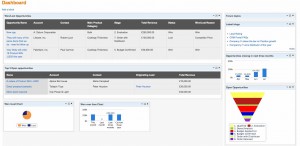 One interesting area of CRM technology whose potential seems yet to be fully realised is the use of portals. A portal is a website that serves as a gateway to the CRM system, and allows third parties, such as customers or partners, the ability to create and update records within the CRM system without being core users. While the potential use cases for portal technology are vast here are a few examples:
One interesting area of CRM technology whose potential seems yet to be fully realised is the use of portals. A portal is a website that serves as a gateway to the CRM system, and allows third parties, such as customers or partners, the ability to create and update records within the CRM system without being core users. While the potential use cases for portal technology are vast here are a few examples:
- Allow customers to log, view, and update technical support tickets
- Allow distributors and resellers to update the status of leads that have been assigned to them
- Allow members of a membership organisation to update their details and renew their subscriptions
- Allow grant applicants to submit and track a funding application to a charitable foundation
- Allow a regulatory body to collaborate with external lawyers on legal cases
- Allow a telemarketing company’s clients to track progress on a campaign
- Allow residents to report and track issues such as abandoned vehicles and fly tipping to the local authority
In other words portals allow external parties to interact with a CRM system without being exposed to the full range of data or the complexity of the core system.
These capabilities have a range of potential benefits:
- Improved customer experience – they can for example log and track matters at their convenience without having to interact directly with a vendor
- Reduced cost of handling transactions/applications/cases/issues – because there’s less data entry involved in processing the matter
- Reduced time to resolution/conclusion
- More effective collaboration with third parties
- Improved depth and quality of data
While some CRM applications have portal capabilities as standard these tend to be limited to more mainstream uses such as case management or partner management. There are however a range of third party applications that allow you to develop less conventional portal applications.
One technology which I’ve implemented a number of times recently, which I particularly like, is Access CRM which has been developed by a company called Webcurl. It’s startlingly cost-effective, starting at £2,500 per year including hosting, but the main benefit is the speed with which a portal can be created, and that it can be set up using an administrative rather than development resource.
It’s developed on the open source Drupal content management system, and so can potentially make use of the wide range of Drupal capabilities and add-ons, such as its multi-language capabilities, and the flexibility in managing the look and feel of the application.
With the availability of these sorts of flexible, cost effective, technologies, the barriers to introducing portal capabilities have been dramatically lowered. As a result there’s even more opportunity for users of CRM technology to improve customer service, and lower costs. With a hugely diverse range of potential use cases, current and prospective users of CRM technology may well profit from reviewing how extending access to the core CRM system to partners and customers through portals may be relevant to them.
![[Facebook]](https://www.mareeba.co.uk/blog/wp-content/plugins/bookmarkify/facebook2.png)
![[Google]](https://www.mareeba.co.uk/blog/wp-content/plugins/bookmarkify/google-plus2.png)
![[LinkedIn]](https://www.mareeba.co.uk/blog/wp-content/plugins/bookmarkify/linkedin2.png)
![[Twitter]](https://www.mareeba.co.uk/blog/wp-content/plugins/bookmarkify/twitter2.png)
![[Pinterest]](https://www.mareeba.co.uk/blog/wp-content/plugins/bookmarkify/pinterest2.png)